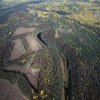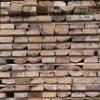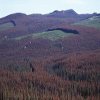BC Interior lumber to peak in three to five years
14 June 2010The British Columbia (BC) Interior’s timber harvest and sawmill production is expected to undergo a long-awaited downsizing as the effects of the mountain pine beetle (MPB) infestation take their toll on the timber supply.
The epidemic is responsible for one of the largest natural environmental catastrophes ever seen, and could eventually kill up to one billion m3 of standing lodgepole pine timber in the BC Interior.
For perspective, the total volume of killed pine trees in the province by 2022 would produce enough lumber to build 40 years’ supply of single-family houses in the US (at today’s low rate), or 175 years’ worth of single-family houses in Canada.
While a massive salvage programme has been underway for much of the last 10 years, several factors – an erosion in log quality, poorer conversion economics and a shorter shelf life for the dead tim-ber – will combine to result in a much smaller BC industry in the future.
The outcome will be sawmill and plywood mill closures that have significant and direct consequences on rural BC communities. Depending on a wide range of market variables and processing assumptions, the BC Interior may be able to delay the inevitable. However, peak saw log availability, in combination with the economics of harvesting, are now forecast to occur within three to five years.The proprietary BC Fibre Model simulates the regional wood fibre supply to 2028 for the eight BC Interior regions most affected by the MPB epidemic. It provides an assessment of the impact the MPB will have on key BC forest prod- ucts, including log supply, softwood lumber, plywood and residual fibre (chips, sawdust, shavings and hog fuel) production.
Sawlog shortages caused by the MPB could trigger the permanent closure of some 16 large primary sawmills and/or plywood production facilities within the BC Interior by 2018 (with more to follow when the beetle has completed its cycle).
Due to differing proportions of pine within each region, and the varying degrees to which the beetles have affected the standing timber, the impacts of the epidemic are different between the eight Interior regions assessed. For instance, some are being impacted severely, while others have experienced virtually no effect at all. This will not be good news for some BC communities, as the expect- ed mill closures will be concentrated mostly in the central Interior region.
The forecast sawmill and plywood mill closures are a function of the so-called ‘shelf-life’ of the dead timber and the declining economics of processing dead logs. Each mill and/or company is approaching the situation of processing the dead timber differently, but the end result appears to be an almost 50% reduction in the long-term timber harvest and lumber production in the BC Interior from its 2005 peak, all due to the MPB epidemic. While the shelf life can be extended significantly by strong lumber markets and higher prices, the reverse is also true.
From peak output of 15 billion board feet in 2005 and just nine billion board feet in 2009 due to the US housing mar- ket collapse, BC Interior lumber produc- tion is expected to peak some time around 2013–14 (based on the ongoing recovery in US demand). After this point, a steady decline in production is expected as the economics of processing mountain pine beetle timber (due to shelf-life issues) decline.
The BC Interior lumber industry will see lower timber harvests and will need to begin reducing production and/or closing mills, and this impact on the US market will soon be profound. So, in conjunction with reduced Canadian timber supply and the lumber output reductions that have occurred in Quebec and Ontario, there will be a noticeable decline in Canada’s lumber supply base and it will be permanent. It takes 70-90 years to grow trees in Canada, so BC and the whole of the country will not see its lumber production return to the lofty levels of 2004-5 for many decades (perhaps up to a century!).
As a result of the impact of the MPB on BC lumber output, there is potential for a North American ‘supply gap’, relative to the traditional operating rates by region and expected North American demand. This is based on possible trends in US softwood lumber supply and projected imports (from Canada, Europe and other sources). This anticipated supply gap is an indication that tightening lumber supply will create some changes in how US lumber demand is to be met as early as the mid-point of this decade.
It also means that Canadian lumber exports and US consumption market share will remain at much lower levels versus the boom years of 1990 to 2005. When trends in lumber imports by country are converted to market shares, the plunge in Canada’s production becomes more evident in its market-share loss. From an historical 32-36% US consumption market share from 1993 to 2007, Canada’s market share under the projected production scenario could drop to about 20% over the forecast period.
The share for Europe is expected to rise steadily from its low rate of less than 1% in 2009.
The import market share for the other supplying regions (mainly southern hemisphere plantation pines) is anticipated to remain steady.
Also impacted in each BC region is the projected byproduct output, including residual wood chip, sawdust, shavings and hog fuel (bark) supplies. Residual wood chips will be surplus to demand in the short-term as sawmills return to more traditional operating levels. However, the surpluses are quite regional in nature, so, over the longer-term, as sawmills close, residual wood chips will once again be in short supply within the BC Interior.
Of note, major shortfalls in sawdust and shavings are also forecast within the Interior; while hog fuel appears to be in balance provincially, regional shortfalls and surpluses are significant. Opportunities may exist for wood pellets, and perhaps biofuels, in the short-term but the supply of long-term residual byproducts will start to be taxed heavily by the existing users.
On a brighter note it is forecast that, in the short-term, more than 225 million m3 of wood biomass – including harvesting waste, unmerchantable timber and some standing dead timber may become available to support new biomass-consuming industries throughout the BC Interior, provided the economics of recovering that fibre can be supported. As sawmill closures occur and the provincial annual allowable cuts (AAC) for timber fall, however, these potential biomass surpluses will be reduced significantly.
The MPB is endemic to parts of western North America and is normally kept in check by cold winter weather (-30°C) which lasts for a period of one to two weeks. In the absence of sustained cold winter temperatures since about 1995, the MPB has devastated the pine forests of the Province of British Columbia, one of the world’s largest pulp and wood products producing regions.



